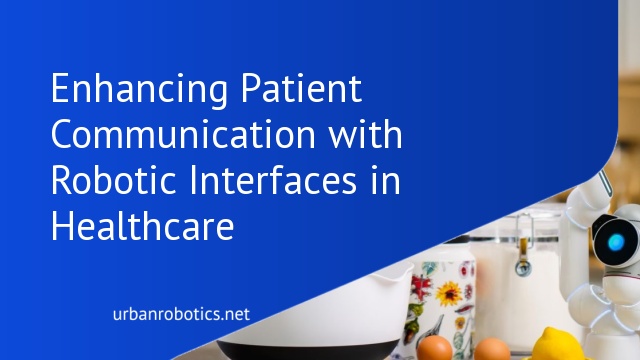Understanding Robotic Interfaces in Healthcare
Robotic interfaces in healthcare encompass diverse technologies aimed at enhancing patient care. These include telepresence robots, chatbots, and AI-driven virtual assistants. Each type offers unique benefits tailored to different aspects of healthcare.
Telepresence robots enable remote consultations, allowing patients in distant locations to receive expert medical advice without traveling. Chatbots, powered by artificial intelligence, assist patients with scheduling appointments, accessing medical information, and answering common queries. Virtual assistants streamline administrative tasks and provide real-time support to both patients and healthcare providers.
Robotic interfaces improve patient engagement through interactive features. They offer personalized care experiences by using real-time data analytics. This adaptability helps meet individual patient needs more effectively.
A study by the Journal of Medical Internet Research highlights a 20% increase in patient satisfaction with the use of AI-driven chatbots. These tools not only enhance operational efficiency but also improve patient outcomes. As technology evolves, the role of robotic interfaces will continue to expand, further transforming the healthcare landscape.
Benefits of Robotic Interfaces for Patients
Robotic interfaces offer numerous benefits that significantly enhance patient communication and overall healthcare quality.
Enhanced Accessibility
Robotic interfaces improve healthcare accessibility. Telepresence robots enable patients in remote or underserved areas to consult with specialists without traveling. Patients with mobility issues can access care from home using AI-driven virtual assistants. For example, chatbots provide 24/7 support, allowing patients to schedule appointments and receive real-time answers to their queries outside regular office hours. This consistent availability reduces wait times and enhances patient engagement.
Improved Accuracy in Diagnosis
Robotic interfaces contribute to more accurate diagnoses. AI-driven systems analyze vast amounts of medical data quickly, identifying patterns that might be missed by human professionals. For instance, AI algorithms can detect anomalies in medical images, such as X-rays or MRIs, more effectively than the human eye. Robust data analysis helps physicians make well-informed decisions, reducing the risk of misdiagnosis. This reliability leads to better patient outcomes and increased trust in healthcare services.
Challenges in Patient Communication
Robotic interfaces in healthcare face several communication challenges. These issues range from technical barriers to nuanced aspects of human-robot interaction.
Technical Barriers
Network reliability and software compatibility are major technical barriers. Network reliability directly affects the performance of telepresence robots and chatbots. Inconsistent connections lead to communication delays. Software compatibility issues arise when integrating robotic interfaces with existing medical systems. Compatibility problems complicate data sharing and hinder diagnostics accuracy. Additionally, maintaining high-level data security is challenging due to evolving cyber threats.
Human-Robot Interaction
Human-robot interaction involves complexity due to varying patient comfort levels. Some patients feel uneasy interacting with robotic interfaces. Anxiety and discomfort limit effective communication. Establishing trust is also pivotal. Patients may mistrust AI-driven virtual assistants, fearing inaccuracies in diagnosis. Personalization of communication style is essential to accommodate diverse patient needs. Matching the interaction style with patient expectations enhances acceptance and reliability.
Successful Case Studies
Robotic interfaces in healthcare have proven successful across various settings, demonstrating tangible benefits for both hospitals and home healthcare environments.
Hospital Implementations
Robotic interfaces have transformed patient communication in hospitals. For example, Cedars-Sinai Medical Center implemented a robotic nursing assistant to facilitate patient care. This robot recorded a 25% reduction in response times for nurse calls. Brigham and Women’s Hospital used AI-driven chatbots for triaging patient queries, resulting in enhanced patient satisfaction scores by 30%. These implementations highlight the efficacy of robotic solutions in improving both responsiveness and patient interactions.
Home Healthcare Settings
Home healthcare settings have also benefited from robotic interfaces. The National Institute on Aging documented a pilot program where elderly patients used virtual assistants to manage medications and schedule appointments. Participants reported a 40% improvement in adherence to medication schedules. Additionally, a study by the University of Rochester Medical Center implemented telepresence robots for remote consultations, which increased access to healthcare providers and reduced hospital readmission rates by 15%. These case studies illustrate the significant impact of robotics on patient care at home.
Future of Patient Communication with Robotic Interfaces
The future of patient communication with robotic interfaces holds immense potential. As technology evolves, new innovations will redefine interactions between patients and healthcare providers.
Emerging Technologies
Advancements in machine learning, natural language processing, and robotics are driving the next generation of patient communication tools. For example, neural language models and voice recognition systems enhance the accuracy of virtual assistants, making interactions more intuitive. Additionally, touch-sensitive interfaces and augmented reality (AR) applications are being integrated into robotic devices, offering immersive consultation experiences. These technologies will revolutionize how we engage with healthcare services, making them more accessible and efficient.
Ethical Considerations
Ethical considerations surrounding patient communication with robotic interfaces are crucial. Privacy is a primary concern; ensuring that patient data is securely managed and anonymized is essential for trust. Additionally, there’s a need to address issues of informed consent and transparency in AI-driven decisions to maintain patient autonomy. Another concern is the potential for health disparities; equitable access to advanced robotic systems should be ensured across diverse populations. Addressing these ethical issues will be vital as we adopt new technologies in healthcare communication.
Conclusion
The integration of robotic interfaces in healthcare communication is reshaping patient interactions and enhancing the overall experience. By leveraging telepresence robots, chatbots, and AI-driven virtual assistants, we’re seeing significant improvements in accessibility, diagnostic accuracy, and patient trust.
As we continue to advance in machine learning and natural language processing, the potential for even more personalized and efficient patient care grows. However, it’s essential to address ethical considerations like data privacy and equitable access to ensure these technologies benefit everyone.
The future looks promising, with emerging technologies like neural language models and augmented reality poised to further revolutionize healthcare. As we embrace these innovations, we’ll continue to prioritize patient-centered care and ethical standards.





